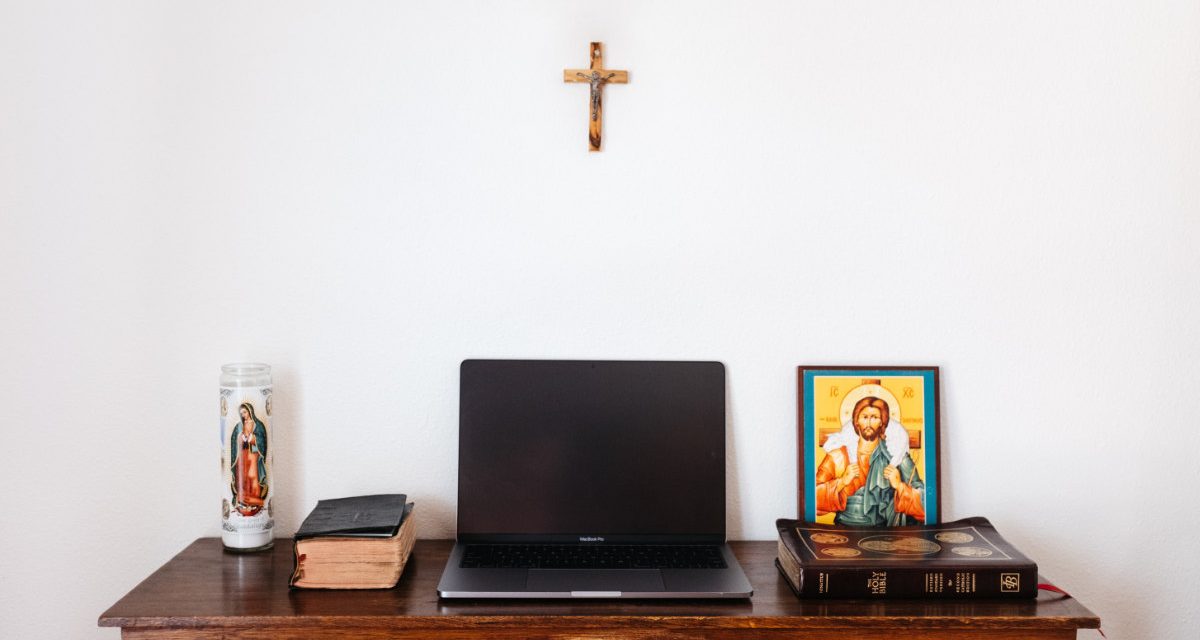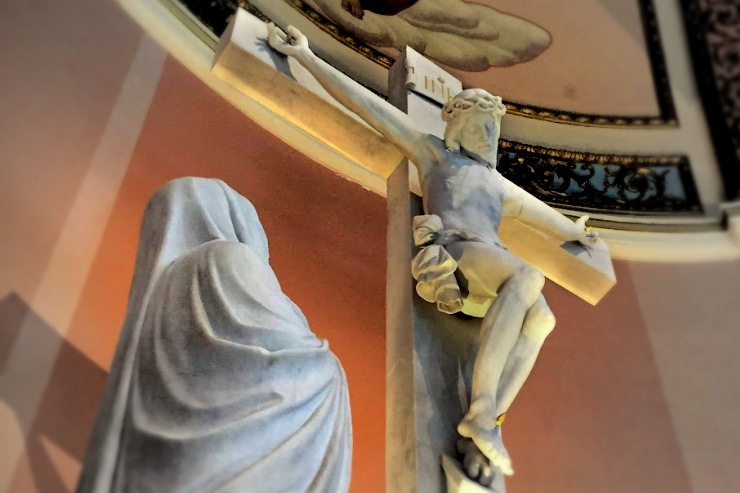How do I integrate my life? By placing reminders in my way, signposts I trip over, that help turn my work, my thoughts, my frustrations, and my daily activities into prayer.
As we strive to integrate the various parts of lives – our jobs, our social activities, our family time, our spiritual lives – sacramentals can help direct our daily activities toward our vocation to holiness. My last two posts looked at what sacramentals are and how they fit into our view of the world and God’s plan to save us. Remember, we aren’t just called to be religious when we are in a church building. We aren’t just Catholic on Sundays. Everything we do can – and should be – for the praise of God. The Second Vatican Council reminds us, “There is scarcely any proper use of material things which cannot be thus directed toward the sanctification of men and the praise of God.” (Sacrosanctam concilium 61)
It’s a reminder to us that God uses the material world He created to advance His Kingdom. First and foremost, he uses us. He also works through created matter – things like water and even ashes. God uses ordinary things to do extraordinary things.
Sacramentals are not good luck charms. They are instruments of God’s grace, which prepare us for the sacraments. The Catechism reminds us, “By them men are disposed to receive the chief effect of the sacraments, and various occasions in life are rendered holy.” (CCC 1667)
Blessings
Blessings come first in the list of sacramentals. Why? Because they “consecrate persons to God, or reserve objects and places for liturgical use.” (CCC 1671-1672) The vows of a religious brother or sister are examples of this. They are being consecrated to God. Their very lives will now be signs to us of the Kingdom of God. God uses them as instruments to bring people to Himself. My sister is a religious sister, and whenever I am with her, I get to witness complete strangers being drawn to Christ through her visible witness of life. Through her vows, she is a walking reminder of her spouse, Christ, and His Kingdom. She draws thoughts back to God in the midst of the classroom, the grocery store, or the airport.
Holy Water
Water has symbolized interior cleansing in every ancient faith. Our use of holy water should help us recall our need for purification. We use it when entering the church to recall our own baptism, our entry into the family of God. It should make us recall the water from the side of Christ, which symbolized that fountain of grace that poured forth from the Paschal Mystery.
Priests use it to bless everything from holy objects like rosaries and statues, to our cars and our homes. Farmers would have their fields blessed to remind them that the land and the fruit it yielded was ultimately God’s. In sanctifying their daily life in this way, work became not just a chore, but a vehicle of God’s grace. Our thoughts are drawn back to the Creator.
Holy water is an especially effective sacramental in the fight against the powers of darkness. Countless saints have written about Satan fleeing from the use of holy water. We know we need this protection. We can and should use holy water in our homes. Place a holy water font near the door to your home, so that you can take advantage of these graces as you enter what may often be a place of worry or stress. Bless your children at night.
Ashes
The ashes we receive on Ash Wednesday are a sacramental. Ash Wednesday is the most crowded unobligatory Mass of the year! In this beautiful ritual, all come forward — rich and poor, old and young – to receive humbly that outwards sign of our repentance. We are all reminded that we were made from the dust of the earth and that we must live not for this life, but for Heaven. The Church uses the blessed palms of Palm Sunday – traditionally symbols of triumph and victory – to make the ashes for Ash Wednesday. We cannot share in Christ’s victory over sin and triumph over Satan unless we practice humility, mortification, and self-sacrifice.
Going to get ashes on Ash Wednesday should not be something we do out of nostalgia, or something we do so we look like other Catholics that day. It should move us to interior repentance. Sacramentals prepare us for the sacraments. These ashes should move us to examine our conscience, feel sorrow for our sins, and confess those sins in the Sacrament of Reconciliation.
Crucifixes and Statues
Why should our classrooms, homes, and if possible, offices be marked as “Catholic” with things like crucifixes and statues? Sacramentals turn our thoughts back to God. We know we are to pray always. We know we should silently talk to God as we go about our day. But how quickly He escapes our thoughts.
The crucifix on the wall of my bedroom that I kiss as I turn in for the evening; the picture of the Holy Family on the living room wall that the mother at her wit’s end throws a desperate pleading look at in the middle of the day; the rosary within reach of the steering wheel of my car; the small cross on the desk at work… all of these things are channels of grace to turn thoughts back to God. We grasp at them in the midst of suffering. They prompt us to prayers of gratitude. They remind us that the situation isn’t as dark as once thought, or that the latest accomplishment is really the work of God.
Through the use of sacramentals, “various occasions in life are rendered holy.” How do I integrate my life? By placing reminders in my way, signposts I trip over, that help turn my work, my thoughts, my frustrations, and my daily activities into prayer.
Image credit: Photo by Grant Whitty on Unsplash
Please help spread the Gospel. Share this post with family and friends on Facebook and other social media.
We strive to operate on a very small budget, but we need your help. Both one-time and monthly donations are welcome. Just $10 a month will help cover the cost of operating Integrated Catholic Life for one day! Please help us bring enriching and inspiring Catholic content to readers around the world by giving today. Thank you!













